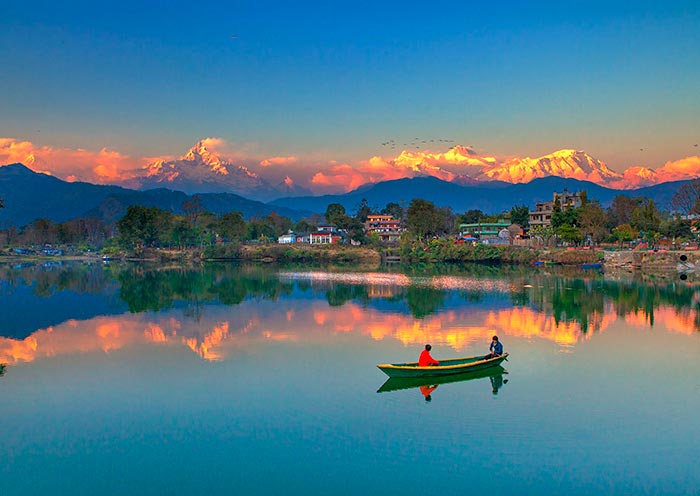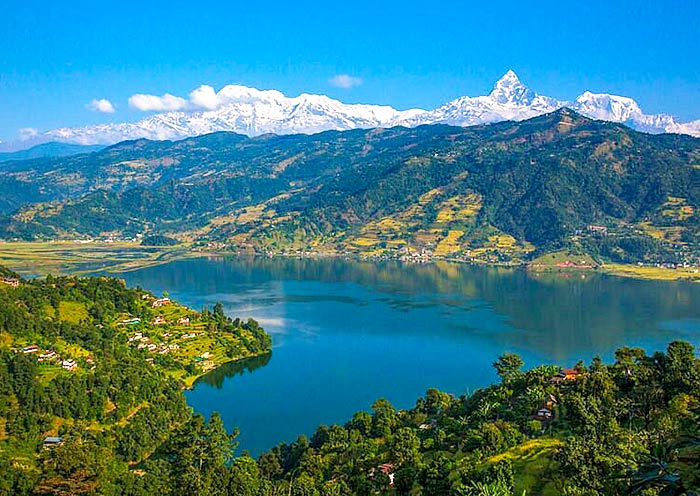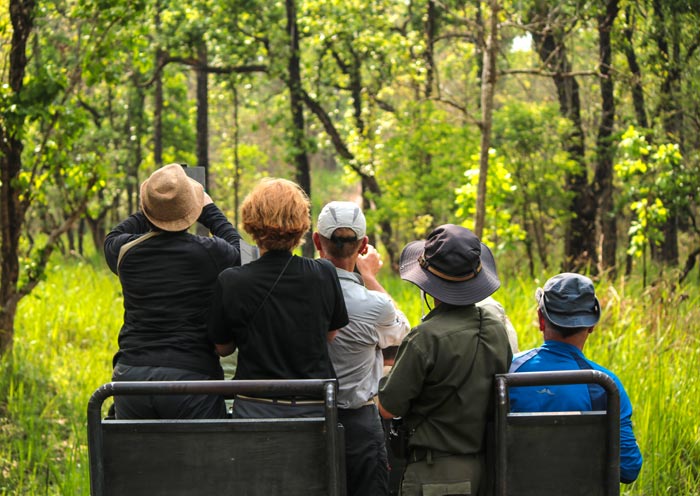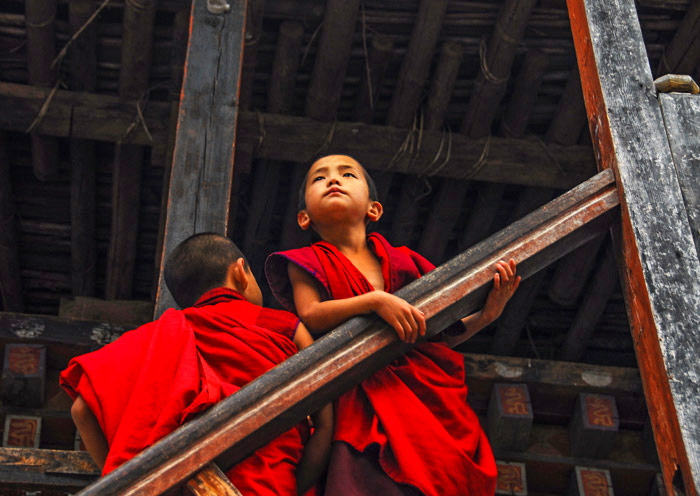- Highlights
- Itinerary
- Price
- Trip Notes
- Accommodation
- Photos
- Reviews
This 12-day Nepal Bhutan Tour is an in-depth exploration of the cultural and spiritual essence of Nepal and Bhutan, covering nearly all the significant cultural and spiritual sites of these two countries. It's ideal for the adventurous soul drawn to the mystique of the Himalayas, the cultural enthusiast eager to delve into centuries-old traditions, and the spiritual seeker looking for moments of reflection and connection.
The journey begins in the Kathmandu Valley, a UNESCO World Heritage site. You will visit the historic Durbar Squares of Kathmandu, Patan, and Bhaktapur, alongside the sacred Hindu and Buddhist sites, allowing you to witness the harmonious coexistence of these two major religions in Nepal.
The journey in Bhutan, starts from the western regions of Paro, Thimphu, and Punakha, Gangtey, moving through the central regions of Trongsa, and ending in the spiritual and cultural heartlands of Bumthang. Paro is home to the iconic Tiger's Nest Monastery, perched dramatically on a cliffside. Thimphu, the capital, offers a mix of traditional and modern life, while Punakha has the most beautiful Dzong in Bhutan. On the way to central Bhutan, you'll visit the beautiful Phobjikha Valley in Gangtey, the winter home of the black-necked cranes. Trongsa features the largest Dzong in Bhutan, a key ancestral home of the royal family. What sets this tour apart is the deep exploration of Bumthang, often referred to as the cultural heart of Bhutan. This area is less frequented by the typical tourist, allowing for a more intimate and authentic experience of Bhutanese culture and spirituality.
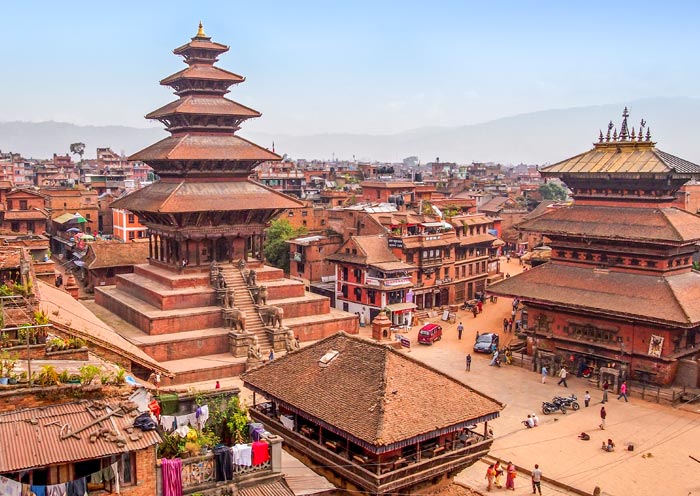
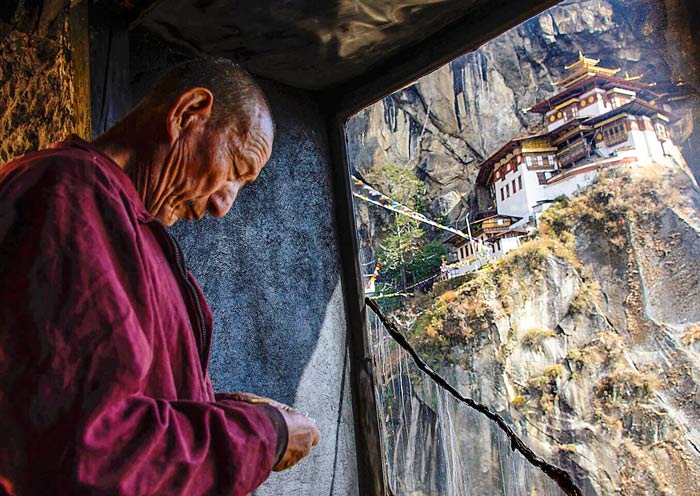
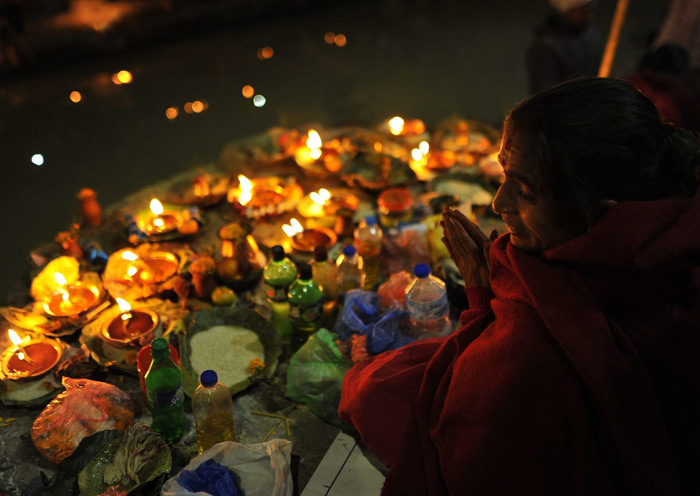
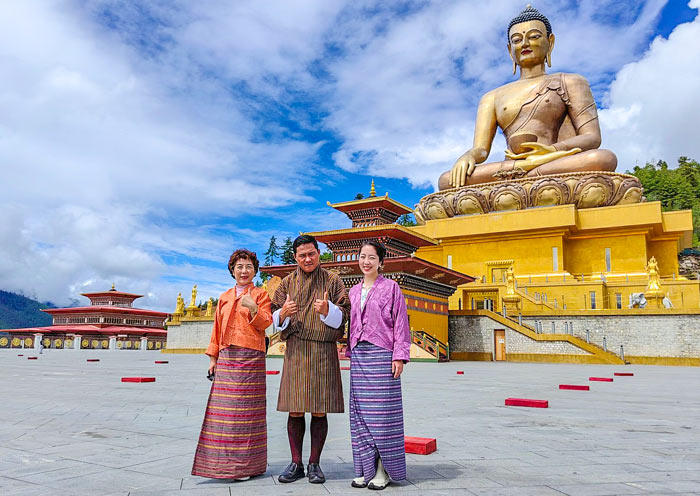
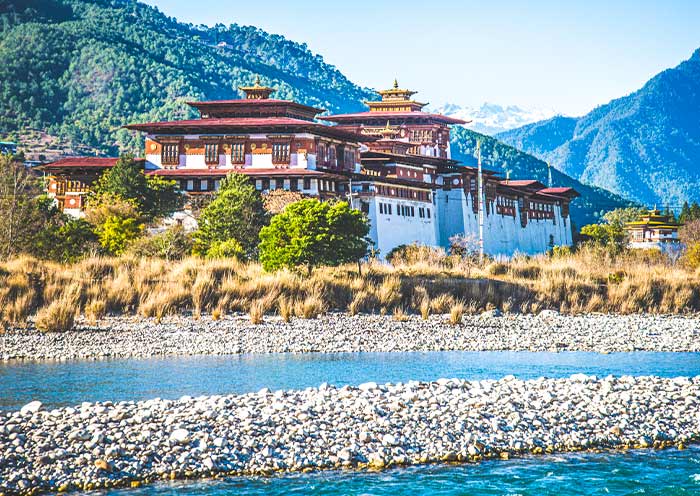
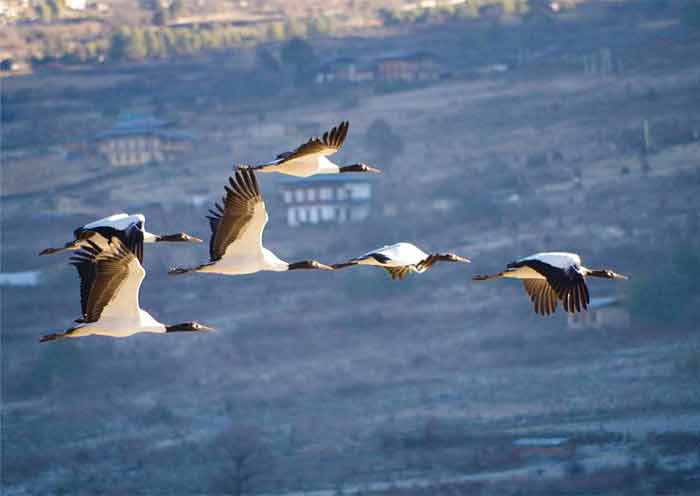
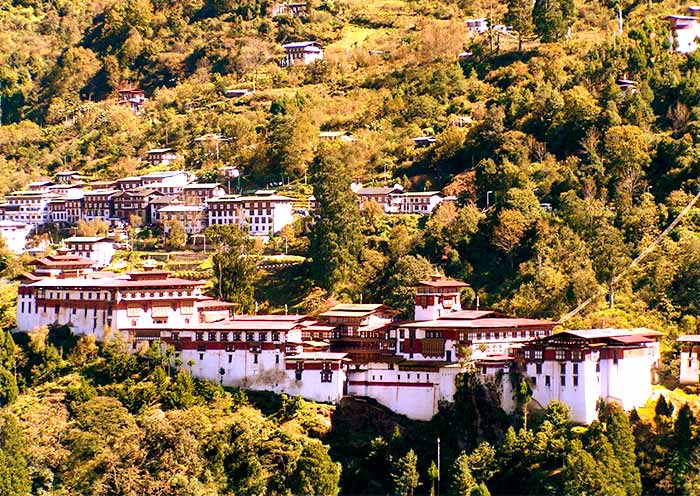
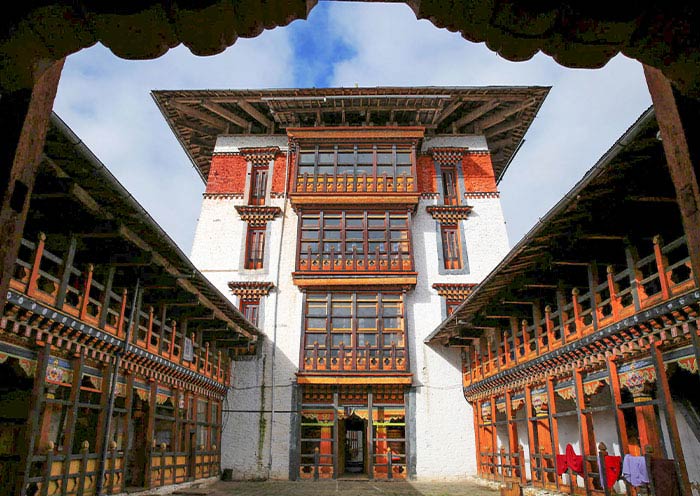
Itinerary at a Glance
Kathmandu, Nepal (2 Days)
Kathmandu Durbar Square, Swayambhunath Stupa, Patan Durbar Square, Bhaktapur Durbar Square, Changu Narayan Temple, Pashupatinath Temple, Boudhanath Stupa
Paro, Bhutan (2.5 Days)
Tiger's Nest Monastery, Kyichu Lhakhang, Kyichu Lhakhang Paro Dzong, Bhutan National Museum
Thimphu, Bhutan (2 Days)
Buddha Dordenma Statue, National Memorial Chorten, Tashichho Dzong (Thimphu Dzong), Bhutan Post Office, School for Arts and Crafts, Simply Bhutan Museum
Punakha, Bhutan (1.5 Day )
Dochula Pass, Chimi Lhakhang, Punakha Dzong
Gangtey, Bhutan (1 Day)
Phobjikha Valley, Gangtey Monastery, Gangtey Nature Trail, Black-Necked Cranes Center
Trongsa & Bumthang, Bhutan (2 Days)
Pele La Pass, Chendebji Chorten, Trongsa Dzong, Kurjey Lhakhang, Jambay Lhakhang, Jakar Dzong, Yathra Weaving
Wangdue Phodrang, Bhutan (1 Day)
Rinchengang Village
Paro, Bhutan
Itinerary Day by Day
Namaste! Welcome to Kathmandu, the capital of Nepal! Upon your arrival at the airport in Nepal, the tour guide and driver will meet you at the exit and then escort you to the hotel in downtown Kathmandu. You can have a good rest in your hotel and get ready to explore Kathmandu Valley with your guide the next day.
Kathmandu is the largest city in Nepal, located in the Kathmandu Valley, which is surrounded by the majestic Himalayan mountain range. The city boasts a rich cultural and historical heritage, with numerous ancient temples, palaces, and monuments. Its architecture beautifully blends traditional Newari style with modern designs. Kathmandu is renowned for its vibrant street life and bustling markets, such as the Asan Bazaar and the Thamel district (street), offering a wide range of goods and services. The city's rich festival culture, stunning architecture, and friendly people make it a popular destination for travelers from around the world.
Arrival Ideas: Kathmandu's Tribhuvan International Airport (KTM) serves as the main gateway to the city, accommodating both domestic and international flights. You can fly directly to Kathmandu from major cities such as Hong Kong (5.5 hours), Chengdu (2.5 to 3.5 hours), Beijing (3.5 to 4.5 hours), Shanghai (4 to 5 hours), and Guangzhou (5 hours 15 minutes) in China. Other cities such as Delhi, Mumbai, Kolkata, and Bangalore in India, as well as Bangkok (Thailand), Singapore, Kuala Lumpur (Malaysia), Dubai (United Arab Emirates), Tokyo (Japan), Seoul (South Korea), London (UK), Paris (France), Frankfurt (Germany), Istanbul, New York, Los Angeles, and Toronto also offer flights to Kathmandu. The availability of direct flights to Kathmandu can also vary depending on the season and airline. So, checking with flight booking websites or our travel consultants for the latest information and options is always a good idea.
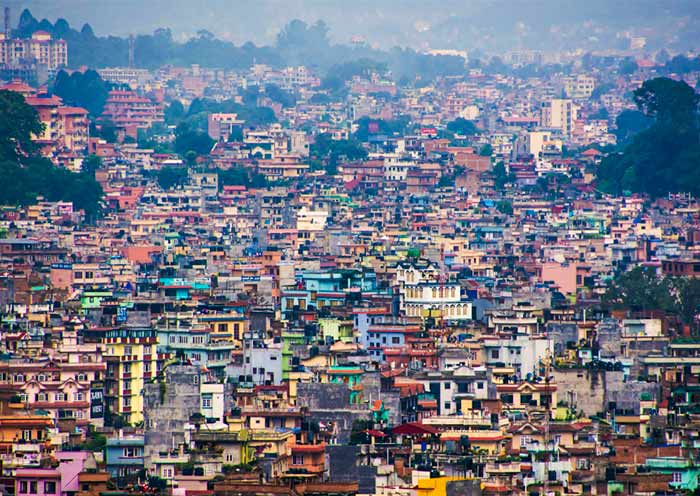
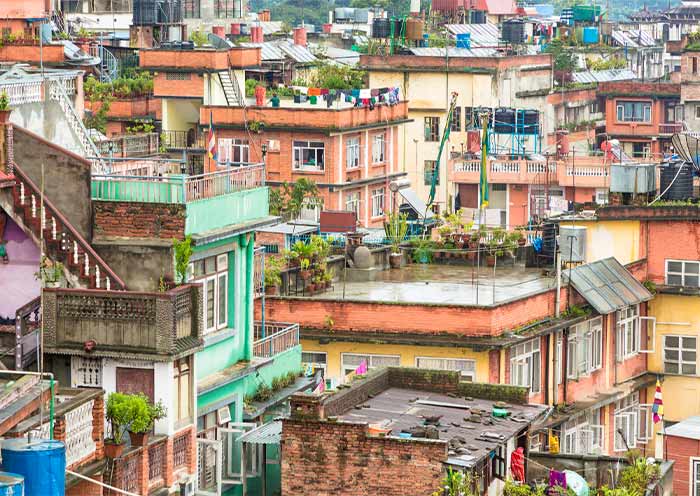
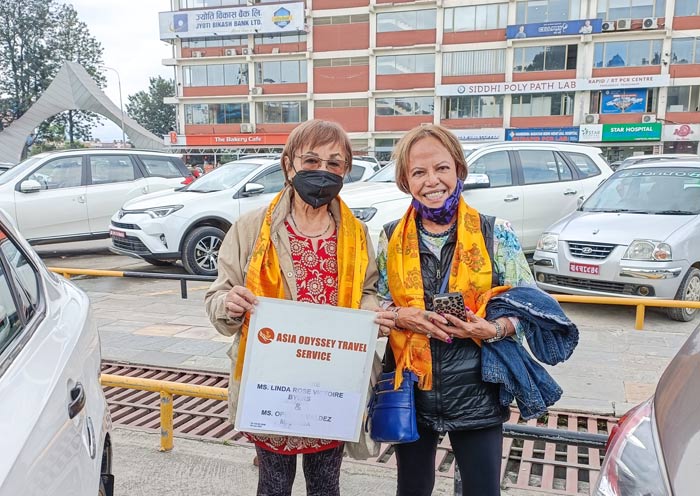
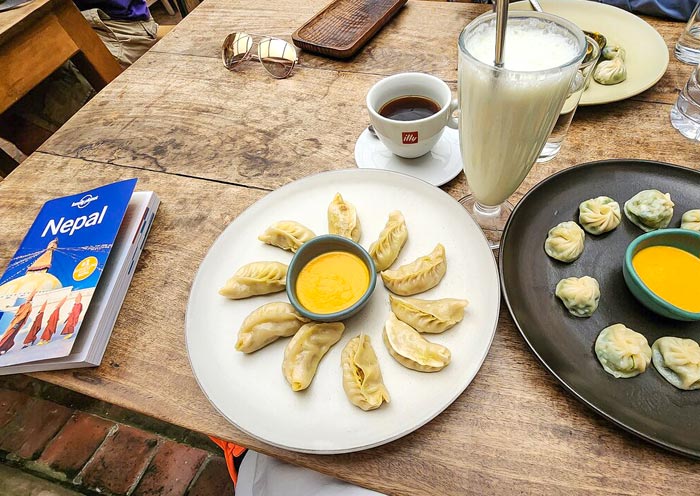
Today, you will explore 3 World Heritage Sites in Kathmandu and Patan. Begin by visiting Kathmandu Durbar Square (World Heritage), one of three royal palace squares in the Kathmandu Valley. You won't miss the Hanuman Dhoka, an iconic red palace adorned with intricate wooden carvings, which served as the residence of Malla Kings for centuries. Most of our guests arm to visit Kumari Ghar (House of the Living Goddess) and Taleju Temple (closely linked to the tradition of the Kumari). Through the Kumari Chowk, you may have the opportunity to catch a glimpse of the Kumari (a young girl worshiped as the living goddess Durga), who is revered by both Hindus and Buddhists in Nepal. The Kumari is selected from a Buddhist family through traditional tests and is believed to be the incarnation of the Goddess Taleju (Durga) until she reaches menstruation age. Dashain Festival (October; a 15-day festival) and Tihar Festival (November; Festival of Lights) offer the best chances of seeing the Kumari in public processions. The Bhairav Statue is also one of the best spots to experience Hindu culture, where you can witness local people worshipping the fearsome god Bhairav, the protector of the city.
Then, move on to Swayambhunath Temple (Stupa), also known as the Monkey Temple due to the swarms of monkeys that inhabit the area. Located on a hilltop on the western edge of Kathmandu, Swayambhunath Stupa (World Heritage) is visible from a distance. You can climb the steep stairs to reach the top of the hill, where you can enjoy panoramic views of Kathmandu Valley and even the Himalayas on clear days. As a must-visit destination in Kathmandu, the stupa is believed to have been built over 2,500 years ago, making it one of the oldest Buddhist sites in the world. The base of the stupa is surrounded by colorful prayer flags fluttering in the wind, carrying prayers and blessings to the heavens. It is a sacred pilgrimage site for both Hindus and Buddhists, signifying the coexistence of diverse beliefs in Nepal while showcasing Newari artistic heritage. Take your time to indulge in the temple's serene and spiritual ambiance, basking in its captivating architecture and embracing its natural beauty.
After that, head to visit Patan Durbar Square (World Heritage), which is 5km away, about a 0.5-hour drive. Located in Patan (Lalitpur), this square is renowned for its ancient architectural masterpieces, including dozens of Buddhist and Hindu temples, pagodas, stone, and wood carvings. Like Kathmandu Durbar Square and Bhaktapur Durbar Square, Patan Durbar Square served as the Royal Palace of the Malla Kings before Prithivi Narayan Shah conquered the Three Malla Kingdoms of Kathmandu, Patan, and Bhaktapur in 1769 and consolidated them to found the modern state of Nepal. He also established the capital of Nepal in Kathmandu. Patan is believed to have been established around 2,300 years ago and is the oldest of the three cities that make up the Kathmandu valley. It is a dazzling display of Newari architecture such as Krishna Mandir (21 golden spires and exquisite stonework), Golden Gate (ornate golden doorway), Sundari Chowk (enchanting courtyard).
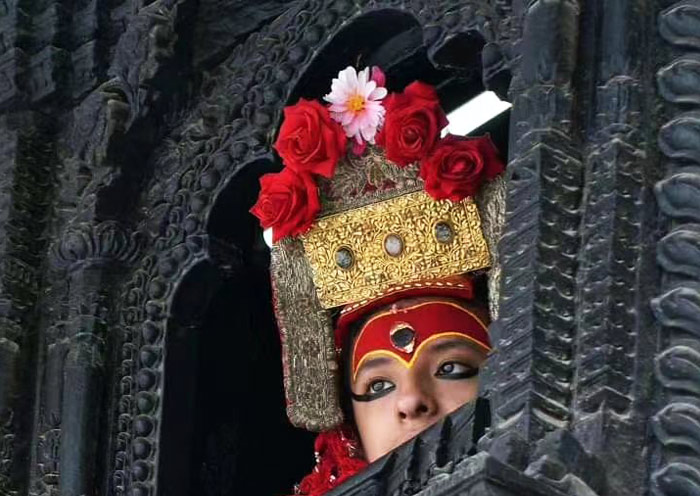
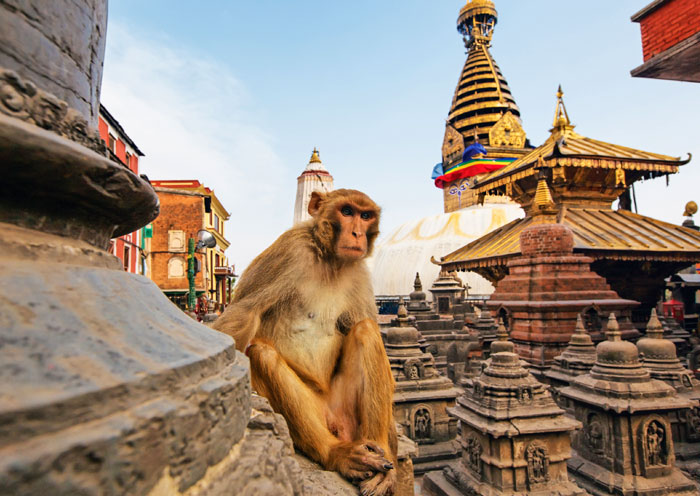
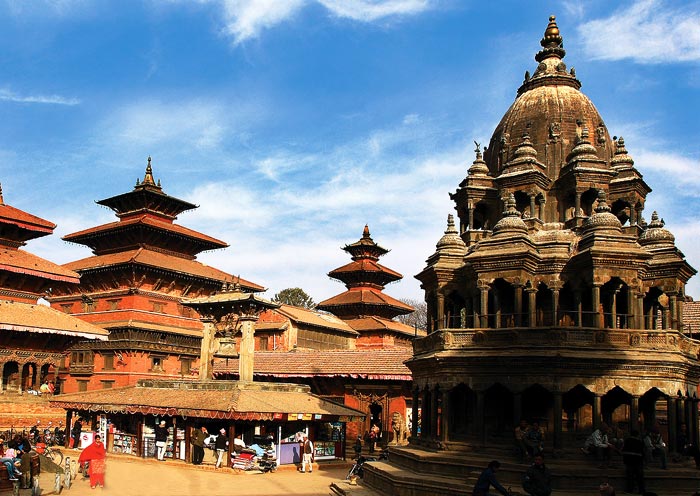
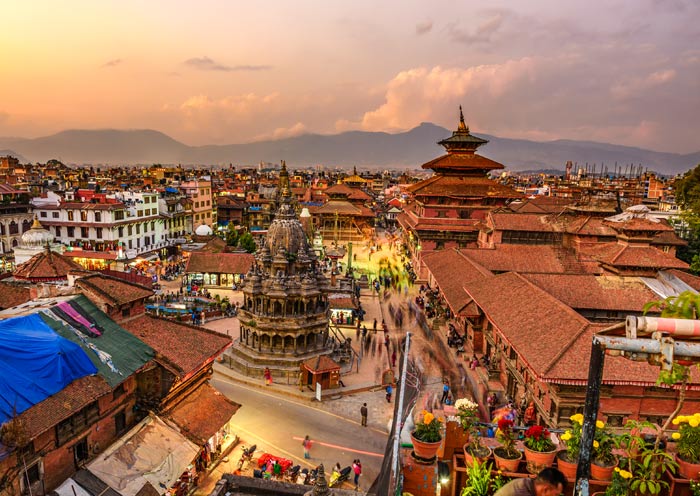
This morning, you will travel about 18 km, taking about 1hour, to reach Bhaktapur (Bhadgaun), also known as An Open Museum. Stepping into Bhaktapur Durbar Square (World Heritage), you will be transported to a bygone era of Malla Dynasty grandeur. It served as the seat of the Malla kings from the 12th to 15th centuries and was the capital of the Greater Malla Kingdom until the 15th century. The square is an assembly of grandiose palaces, courtyards, and temples. Among these, the 55 Window Palace is particularly notable for its intricate wooden carvings and the elaborate balcony that gives the palace its name. The Golden Gate, which serves as the entrance to the main courtyard of the palace, is an exemplary work of repoussé artistry, adorned with figures of deities and mythical creatures. The Nyatapola Temple, which towers above the square with its five-story structure, is the tallest temple in Nepal. Nearby, the Vatsala Temple, with its distinctive stone construction and the famous "bell of barking dogs," adds to the square's spiritual ambiance. Enjoy leisurely walks in this living museum, where festivals, rituals, and daily activities continue to reflect the traditions of the Newar people. Bhaktapur is also famous for its pottery, and if time permits, you can visit Pottery Square to see pots being thrown, dried in the sun, and fired.
Next, drive to visit another World Heritage site called Changu Narayan Temple (7km, 0.5h). Dedicated to Lord Vishnu, this temple is revered as the oldest in Nepal, with origins dating back to the early 4th century. Architecturally, this temple is a masterpiece of Nepalese temple design, showcasing the two-tiered Pagoda style. The temple complex is adorned with intricately carved wood, metal, and stone artworks that depict various deities, as well as scenes from Hindu epics like the Mahabharata and Ramayana. While wandering in the temple, you can read more about Hindu mythology and marvel at the skill of ancient Nepalese artisans and their artworks from the 5th to the 12th century. The hilltop location offers breathtaking views of the Kathmandu Valley.
Then, head back toward Kathmandu (20km, 1h) and pay a visit to Pashupatinath Temple (World Heritage) - a stunning pagoda-style Hindu temple dedicated to Lord Shiva. As the oldest Hindu temple in Nepal, dating back to around 400 B.C., the main temple complex located at the Bagmati River is only open to Hindus. However, non-Hindus can observe the temple from the terraces on the east side of the river. Pashupatinath is often regarded as the Nepali equivalent of Varanasi in India. Originating in the Himalayan Mountains, the Bagmati River is believed to possess purifying qualities for the soul and holds immense sacred significance for both Hindus and Buddhists. Along the banks, there are platforms dedicated to cremation rites. For generations, families have brought the bodies of their loved ones who have passed away to the river, washing their feet and sprinkling drops of water on their faces. It is believed that the river washes away a person's sins and facilitates their journey to heaven. The bodies are then cremated along the riverbanks, and the ashes are scattered into the water. From across the river, you will notice numerous hermit caves to the north of the cremation platforms. For centuries, hermits and ascetics have been meditating in these caves, and this practice continues to this day. Slow down in NEPAL, the place well-known as Never Ending Peace And Love.
At last, you will head to Bodhnath which is a focal point for Tibetan Buddhism in Nepal and home to Boudhanath Stupa (one of the largest Buddhist stupas in the world). You can join the Tibetan pilgrims, and walk around the Boudhanath Stupa (World Heritage) clockwise, turning the prayer wheels under the protective gaze of Buddha's eyes. This is a way to show respect for the Buddha and to accumulate merit. The Boudhanath Stupa is 36 meters tall and 108 meters in diameter, designed as a mandala to represent the Buddhist cosmos. The structure is dominated by a massive dome, at the top of which sits a square tower adorned with the omnipresent eyes of Buddha, gazing serenely in the four cardinal directions. These eyes symbolize the omniscience of Buddha, offering protection and wisdom to all who seek refuge. Surrounding the stupa, prayer flags flutter in the wind, carrying mantras and prayers for peace, compassion, strength, and wisdom far and wide. In the evening, thousands of butter lamps illuminate the plaza surrounding the stupa. Equally fascinating are the surrounding streets, lined with Tibetan monasteries and shops selling religious art, Tibetan handicrafts, and traditional Nepali items.
Stay overnight in Kathmandu.
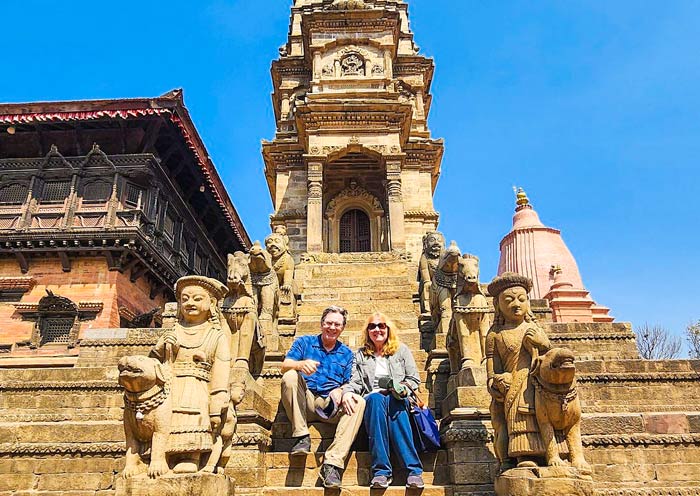

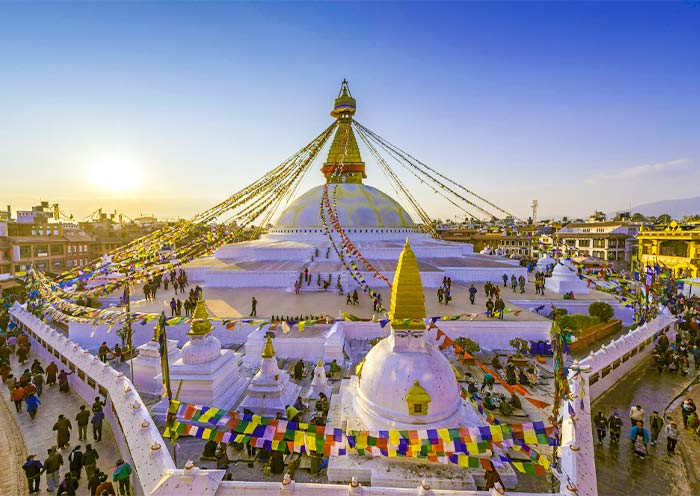
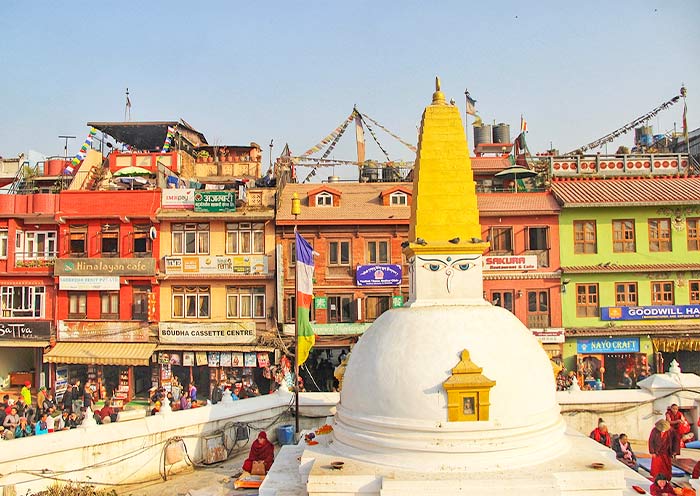
In the early morning, you will be taken to the airport for the flight from Kathmandu to Paro, which is regarded as one of the most beautiful air route in the world. As you take off from Tribhuvan International Airport in Kathmandu, prepare to be mesmerized by the unparalleled views of the majestic Himalayas, including glimpses of the world-renowned Mount Everest, Lhotse, and Makalu, weather permitting.
Kuzuzangpo la! Welcome to Bhutan, the Last Shangri La in Pristine Himalayan Kingdom. Take a deep breath and enjoy the refreshing breeze in the happy country where 71% of the land is covered with forests. Your guide and driver in Paro will greet you at Paro International Airport, Bhutan's only international airport. As complimentary value-added services, Asia Odyssey Travel will provide you with Bhutan's National Dress (Gho or Kira) experience.
Then, we will head to Thimphu, the capital city of Bhutan, which is approximately 50km away and takes about 1.5 hours to reach. Unlike many capital cities dominated by skyscrapers and heavy traffic, Thimphu doesn't have traffic lights or a railway system. Surrounded by rolling mountains, Thimphu is known for its picturesque scenery, Bhutanese dzong, Buddhist monuments, and traditional arts and crafts. Thimphu is committed to preserving its cultural heritage and natural environment while slowly embracing modernity. Once in Thimphu (2,340m), you can enjoy your exploration in Thimphu, including visiting the Buddha Dordenma Statue (Bhutan Point), the National Memorial Chorten, and Tashichho Dzong.
You will visit the iconic landmark of Thimphu city - the Buddha Point first. It is the largest sitting Shakyamuni statue in the world that completed in 2015. The statue embodies an ancient prophecy of radiating happiness and peace throughout the world. In addition to admiring its impressive height of 51.5 meters, constructed of bronze and gilded in gold, you will also be able to see 125,000 smaller Buddha statues placed within it. Moreover, from this vantage point, you can enjoy a magnificent view of the Thimphu Valley.
The National Memorial Chorten is the most visited landmark in Thimphu. Constructed in 1974 in memory of the Third King, His Majesty Jigme Dorji Wangchuk (known as the Father of Modern Bhutan), by his mother, it reflects the late king's vision of promoting world peace and prosperity. The Chorten follows a Tibetan-style architecture and is adorned with remarkable paintings and intricate sculptures. You can observe the traditional stupa design, featuring a pyramidal pillar topped with a crescent moon and sun.
Then, you should not miss the visit to Tashichho Dzong (Thimphu Dzong), which has served as the seat of the government since 1952. This magnificent fortress-like structure is located on the western bank of the Wang Chu River. It seamlessly integrates with the entire valley and stands as the ultimate center of power in Bhutan. It houses the offices of the current reigning monarch, the Fifth King (Jigme Khesar Namgyel Wangchuck), as well as the ministries of internal affairs and finance. Additionally, it serves as the residence of the spiritual leader of Bhutan, the Je Khenpo, and hosts the central religious institutions of the country. During the summer season, the Je Khenpo resides in the Thimphu Dzong, while in the winter season, they relocate to Punakha Dzong. Walking around the Dzong, you will discover that it is an impressively large structure surrounded by well-kept lawns and beautiful gardens. Tashichho Dzong has two main entrances. One entrance leads to the administrative section in the south, while the other, situated in the north, grants access to the monastic quarter where the Thimphu Tshechu Festival and masked dances are performed. Note: The tourist opening hours of Thimphu Dzong are from 5 PM to 6:30 on weekdays and from 10 AM to 4 PM on weekends. It is required to have a tour guide accompany you for a visit to the Dzongs. Before entering for a visit, security checks are conducted.
For dinner, you will have the opportunity to enjoy a welcome dinner with a Bhutan Culture Dance Show. Afterward, you can check in at your cozy hotel in Thimphu, where you can rest and adjust to any time difference.
Stay overnight in Thimphu.
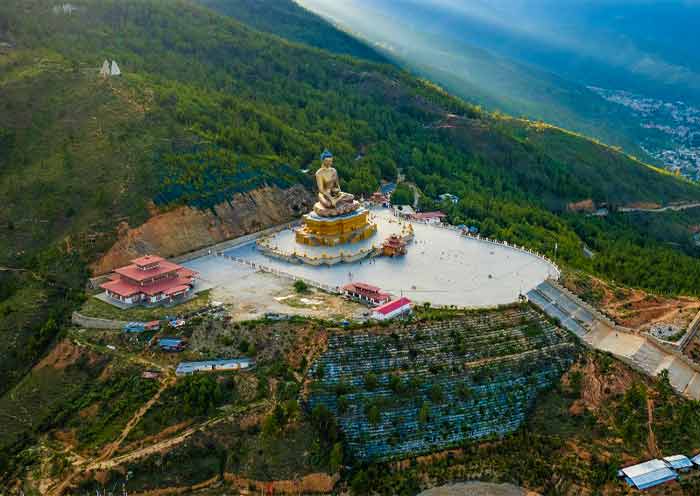
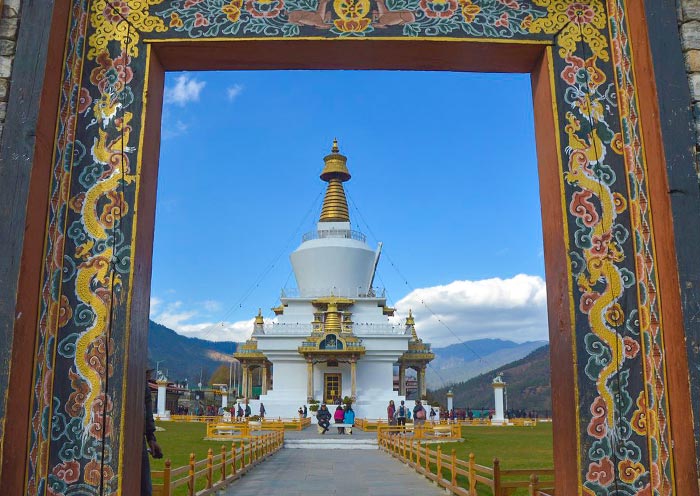
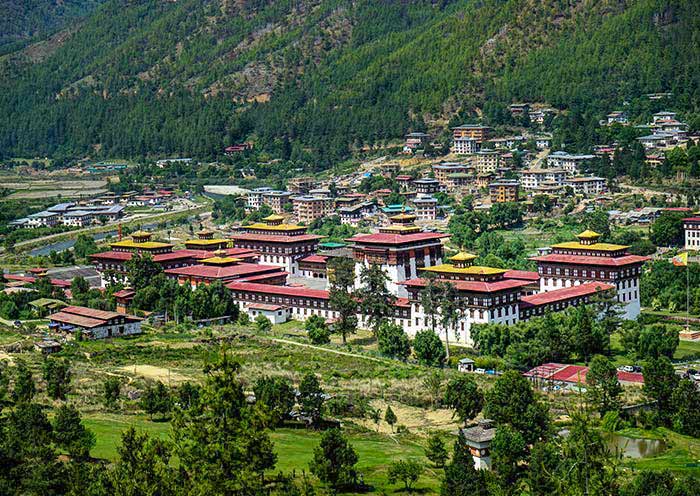
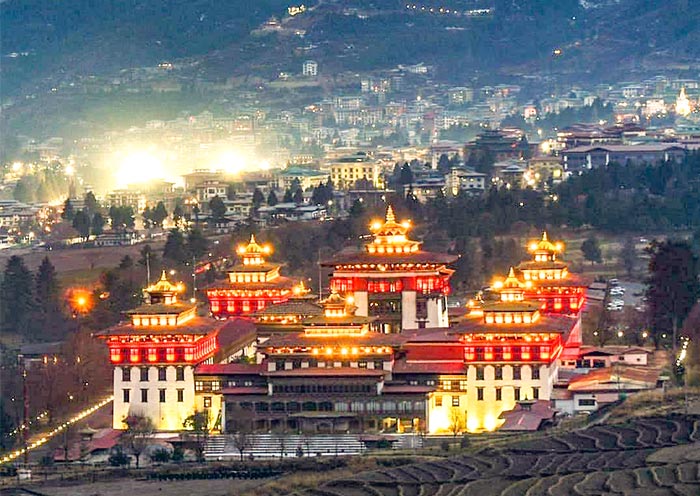
This morning, you will first pay a visit to the Bhutan Post Office Headquarters (General Post Office) first for fully functional stamp printed with a self-portrait. This post office is known for housing the world's largest photo book and an intriguing collection of Bhutanese stamps. It is the only place where you can obtain personalized stamps featuring your own face. (Open hours for the post office: Weekdays: 9AM - 5PM; Saturdays: 9 AM - 1 PM; Closed on Sundays).
Then, you can visit School for Arts and Crafts, also known as the Thimphu National Institute for Zorig Chusum, and delight in the abundance of Bhutan's traditional arts and skills. This institution showcases the mastery of the country's 13 arts and crafts, offering a captivating experience of Bhutan's rich artistic heritage. Students here undergo rigorous training for 4-6 years, mastering the techniques and artistic nuances of their chosen craft. The 13 art forms are Traditional Painting, Sculpturing, Wood Carving, Calligraphy, Papermaking, Bronze Casting, Embroidery, Weaving, Carpentry, Masonry, Bamboo and cane weaving, Gold/Silver Smithy, and Black smithy.
Next, you can explore the Simply Bhutan Museum. Simply Bhutan Museum is a "live" museum that allows you to view various aspects of the traditional life of Bhutan. You can touch and take pictures while witnessing the culture of Bhutan through household tools and other items of Bhutanese origin. Just follow the museum docent, who dresses up in traditional clothes, to try local rice wine, observe the traditional way of building houses out of rammed earth, sip local milk tea while enjoying Bhutanese songs and folk dances, and try archery, which is Bhutan's national sport. During your visit, you will have the opportunity to meet Pema Tshering, a talented craftsman. Despite being born with cerebral palsy and congenital deformities in his spinal column, he skillfully carves wood using his feet. The museum also features souvenir stalls and a restaurant that serves Bhutanese set meals.
This afternoon, you will depart from Thimphu to Punakha via Dochula Pass (74km, about 2.5 hours). Starting from the higher altitude and cooler climate of Thimphu (2,300m), the drive takes you along the national highway, ascending through the majestic Dochula Pass (3,120m). Upon crossing the pass, you'll descend into the warm and verdant Punakha Valley (1,330m).
Accommodate in Punakha.
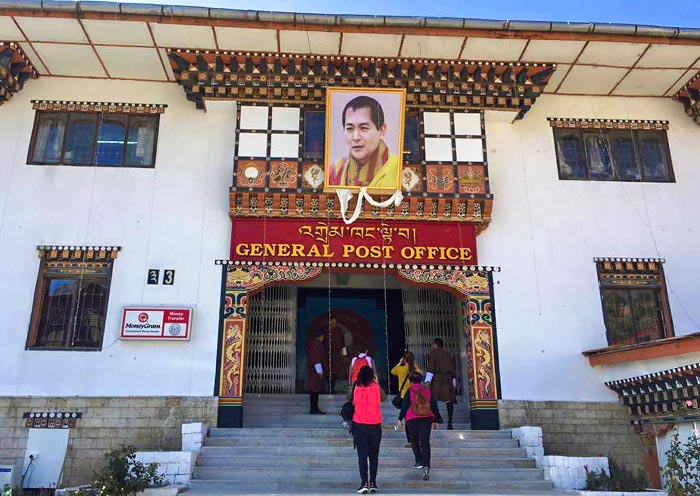
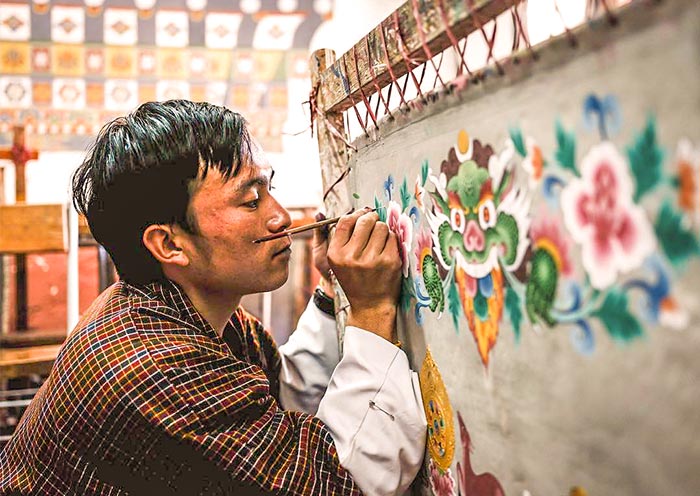
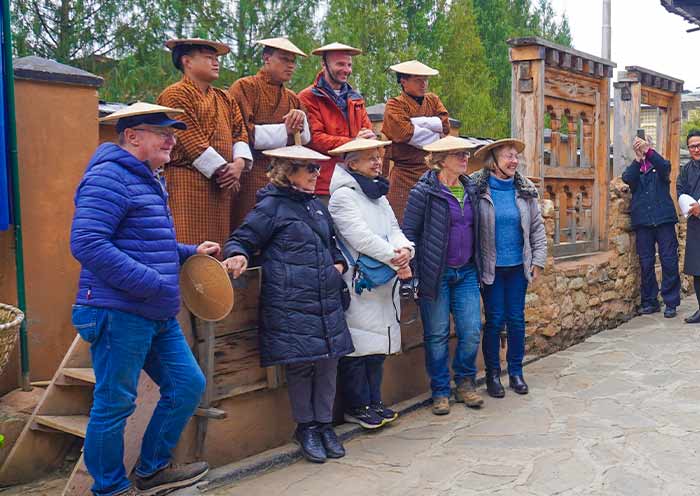
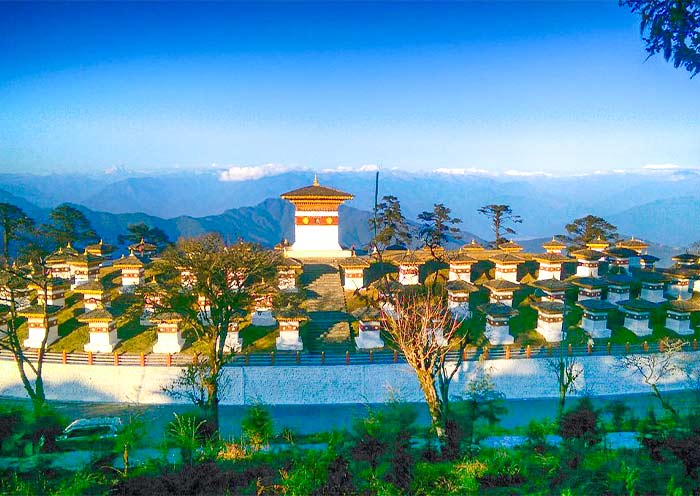
After breakfast, you will explore the most beautiful Dzong of Bhutan. It is located at the confluence of the Mo Chhu (Mother River) and Pho Chhu (Father River). Dominating the river junction is the magnificent Punakha Dzong, the winter residence of Je Khenpo (head abbot of Bhutan) and about 1,000 monks. Occasionally, you'll spot monks draped in red robes passing by, their rhythmic chanting and prayers echoing in the air. Punakha Dzong, the second oldest and second largest Dzong in Bhutan serving administrative and monastic functions holds a legendary tale. It is said that Guru Rinpoche (Padmasambhava) prophesied the arrival of a person named Namgyal built a Dzong on a hill resembling an elephant. In 1637, Shabdrung Ngawang Namgyel, the unifier of Bhutan, received a divine vision guiding him to construct a Dzong at this site. All of Bhutan’s kings have been crowned here and In 2011, the Dzong bore witness to the royal wedding ceremony of His Majesty Jigme Namgyel Wangchuck, the 5th King of Bhutan, as he married Queen Jetsun Pema. As the most beautiful Dzong in Bhutan, if you visit in April, you won’t miss the stunning violet blossoms of the jacaranda tree outside Punakha Dzong. The jacaranda typically blooms from late March to early May, During this time, the grounds of Punakha Dzong transform into a magical carpet of purple under the clear blue skies, creating a truly breathtaking sight. If you visit during the Punakha Tshechu Festival, you can enjoy the mesmerizing masked dances and witness the exhibition of a large thangka depicting the Zhabdrung (Shabdrung, the father of Bhutan) once a year. You can have fun with locals who flood here dressed in Bhutan’s national attire, with men wearing Gho and women wearing Kira.
After crossing the Bazam Bridge, you can walk inside the Punakha Dzong and take your time to admire this stunning example of Bhutanese Dzong architecture which was built of stone, pounded mud, and a considerable amount of timber (without nails, written plans, or designs). There is a six-story central tower called utse standing in the yard of the Punakha Dzong. As the highest architecture within the Dzong, utse houses the most sacred temples and shrines and contains important religious artifacts, thangkas, statues, and texts. This Dzong has three docheys (courtyards) instead of the usual two. The first (northern) courtyard is for administrative functions and houses a huge white Victory Chorten and Bodhi tree. The second courtyard houses the monastic quarters and is separated from the first by the utse. In this courtyard, there are two halls; one of Ugyen Wangchuck (the King of Bhutan) and another hall where the King was decorated in 1905 with the Order of the Knight Commander of the Indian Empire by John Claude White. In the third (southernmost) courtyard is the temple where the remains of the Pema Lingpa (a treasure revealer, Five Terton Kings) and Shabdrung (founder of Tshechu Festival and Bhutan National Dress) are preserved. At the south end, there is the kunrey, or "hundred-pillar" assembly hall with exceptional murals that depict the life of Buddha.
After that, you will pass near the village of Sopsokha, where a visit to Chimi Lhakhang is highly recommended. Here, you can witness the unusual traditional and cultural ceremonies. Reaching the monastery involves a short and delightful walk across rice paddies and through a small settlement of painted houses and lots of little craft shops. Constructed by the cousin of Drukpa Kunley, the temple was built to commemorate the victory of Drukpa Kunley (Mad Saint & Divine Madman) over the demon of Dochu La using his "magic thunderbolt of wisdom "(phallus). That is why you can see the symbol of the phallus scattered throughout. Chime Lhakhang is renowned as a sanctuary of fertility, and many childless women sought blessings from the lamas at the monastery. It is believed that these couples often find success in conceiving soon after their visit. If you are lucky, you may encounter the monks there blessing pilgrims or women who wish to conceive by tapping their heads with a 25cm wooden phallus. In Bhutan, it is common for local people to utilize the phallus symbol to ward off the evil eye and deter malicious gossip.
After, drive to Gangtey (74KM, about 2.5hrs). And stay overnight in Gangtey.
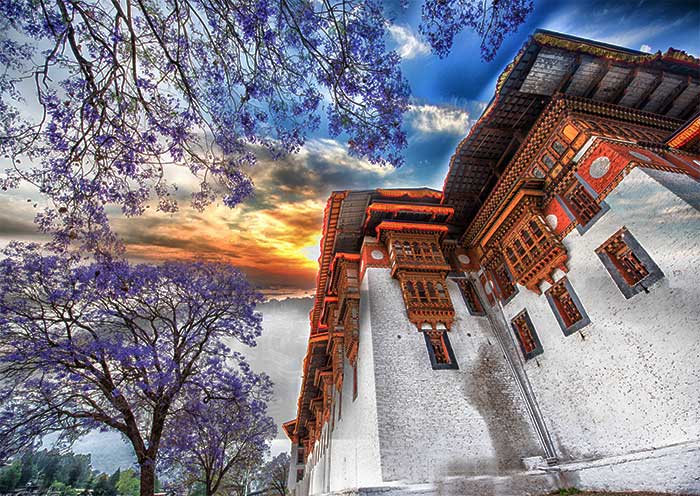
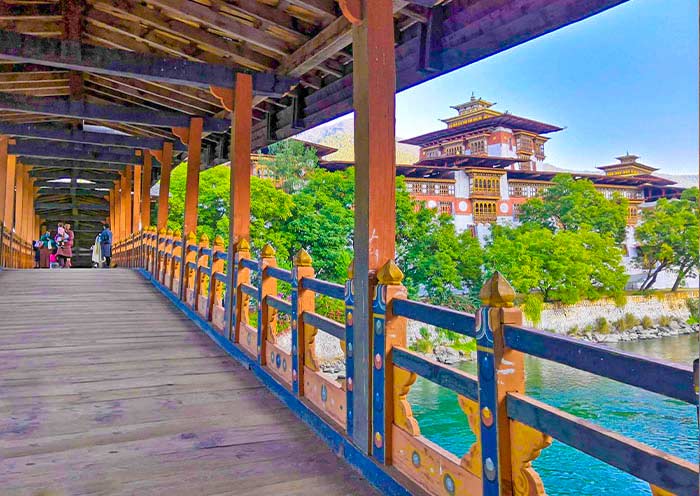
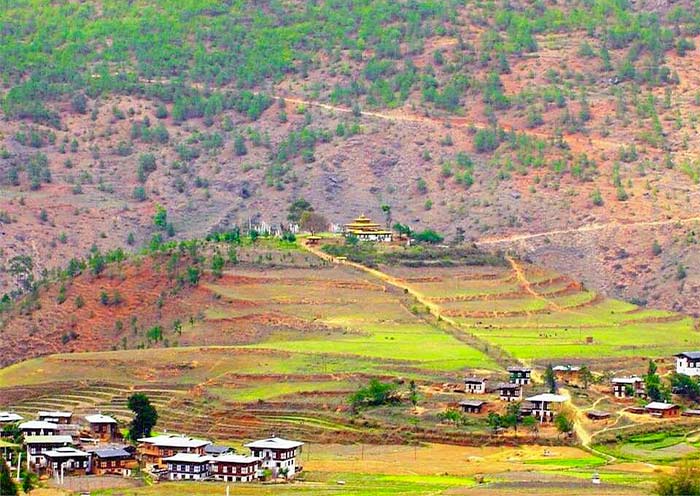
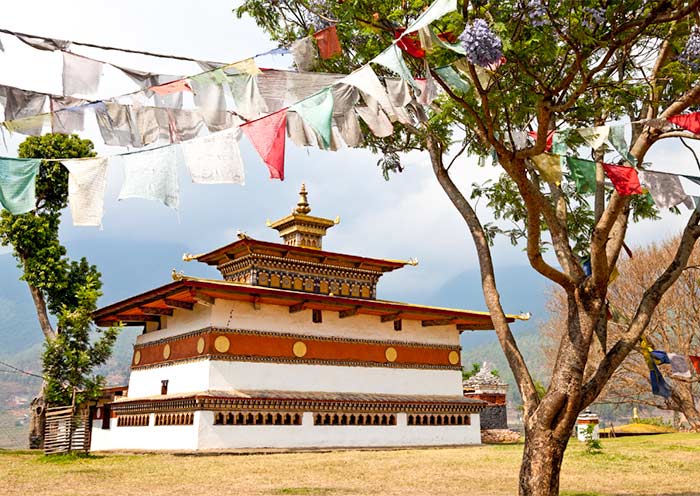
Phobjikha Valley is a U-shaped glacial valley on the western slopes of the Black Mountains, bordering the Jigme Singye Wangchuck National Park. The valley houses one of the impressive ancient Buddhist monasteries in Bhutan known as Gangteng Monastery, and as a result, some people refer to this entire region as Gangtey. Because of the large flock of black-necked cranes that winters here, it is one of the most important wildlife preserves in the country. It offers beautiful trails for hiking and nature walks, allowing visitors to experience its tranquility and natural beauty up close.
This morning, we will have a light hike on Gangtey Nature Trail (4km, 1.5-2 hours) that starts from Gangtey Monastery (3030m) and descends to Khewang Lhakhang (2850m). It is the most beautiful and shortest of the existing nature trails in Bhutan. You can immerse yourselves in the beauty of the Phobjikha Valley(2840m) with farmhouses, dense pine forests, rhododendron forests, and bamboo plants on foot and get a glimpse of the rural and pastoral lifestyle. During the winter (between late October and late February), it may be a bonus to see the rare and endangered Black-neck Cranes. Tips: 1. Dress in layers and wear comfortable hiking shoes. The weather can change quickly in the mountains. 2. Respect wildlife and maintain the cleanliness of the trail.
Gangtey Monastery (Gangtey Goemba, Gangtey Gonpa) was first built in 1613 by Pema Thinley, the grandson, and re-embodiment of Pema Lingpa (the reincarnation of Guru Rinpoche, 1450-1521). It is a beautiful temple architecture that stands on the hilltop and is a great spot to view the picturesque Phobjikha Valley. The Monastery's history traces back to the prophecies made by the well-known Terton (treasure finder) Pema Lingpa in the late 15th century that a goemba (monastery) named gang-teng (hilltop) would be built on this site and that his teachings would spread from here. Now the Monastery is one of the main seats of the religious tradition based on Pema Lingpa's revelations and one of the two main centres of the Nyingmapa school of Buddhism in the country. It is said that on arrival in the Phobjikha Valley in the last week of October, the black-necked cranes circle the Gangteng Monastery three times and also repeat the process while returning to Tibet. Bhutanese have great respect for these “heavenly birds”. Each year on Nov. 11, the Black-necked Crane Festival with local songs, dramas, and masked dances is held at the courtyard of Gangtey Goemba to celebrate the arrival of the endangered bird migrating from the Tibetan Plateau.
At the end of the trail, you will find Khewang Lhakhang, located on the east side of the Phobjikha valley. This 15th-century temple is one of the oldest in the valley and it showcases three impressive two-storey statues of the past, present, and future Buddhas (dusum sangay).
In the afternoon, we will drive to the Black-necked Cranes Information Center, which has informative displays about the black-necked cranes and the valley environment. You can enter the observation room and use the telescope and spotting scopes to watch the Black-necked crane (Grus nigricollis). Every year (Oct. to Feb.), over 300 cranes migrate from Tibet to Bhutan for their winter months in Phobjikha Valley. It has been helpful for the center to protect and conserve the Black-necked crane and its species since 2003. It is a nice place to know more about the cranes and study their behavior.
After that, drive from Gangtey to Trongsa (about 80km, 2 hours). Set your sights eastward towards Trongsa Dzong. Traverse through the dense forests as you make your way to the majestic Pele La Pass, standing at an altitude of 3420 meters, serving as the gateway to Central Bhutan. From this pass, you will enter the expansive and captivating Mangde Chhu Valley, a land of open spaces and natural splendor. Along the journey, you will encounter the Chendebji Chorten, a magnificent white stupa constructed in the 19th century, inspired by Nepal's revered Swayambhunath. Continuing on, follow the winding zigzag road through the valley, treating yourself to a breathtaking view of Trongsa Dzong.
If time allows on this day, pay a visit and marvel at the grandeur of Trongsa Dzong, which boasts the most impressive architecture in Bhutan. It stands on the edge of a gorge, perched at an altitude of 2200 meters, with its narrow and sprawling design gracefully occupying the entire mountainside. Trongsa Dzong is not only strategically located and eye-catching but also steeped in a rich history. It is the birthplace of the current Wangchuck dynasty, with its first structure erected by Ngagi Wangchuck in 1541. The dzong holds close ties to the royal family, as it served as the seat of power for the first and second kings of Bhutan. Even the current fifth king previously held the position of regional governor of Trongsa before ascending to the throne.
Within the massive fortress of Trongsa Dzong, you will find an impressive collection of 23 temples, making it the largest dzong in scale among Bhutan's architectural wonders. Most of these temples are not accessible to the public, creating a labyrinthine maze of corridors, temples, offices, classrooms, and monk residences. Today, Trongsa Dzong serves as a museum, where the history of the Bhutanese royal family and sacred Buddhist artifacts are showcased. The pinnacle of the museum experience lies on the top floor, offering a mesmerizing 360-degree panorama of Trongsa's enchanting scenery. Standing on the circular top floor, you can admire Trongsa Dzong, the neighboring villages, and the majestic surrounding mountains, all captured in a single breathtaking view.
Stay overnight in Trongsa.
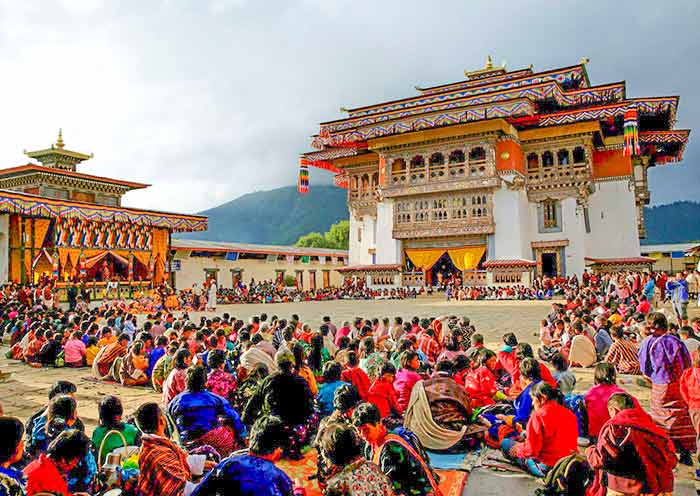
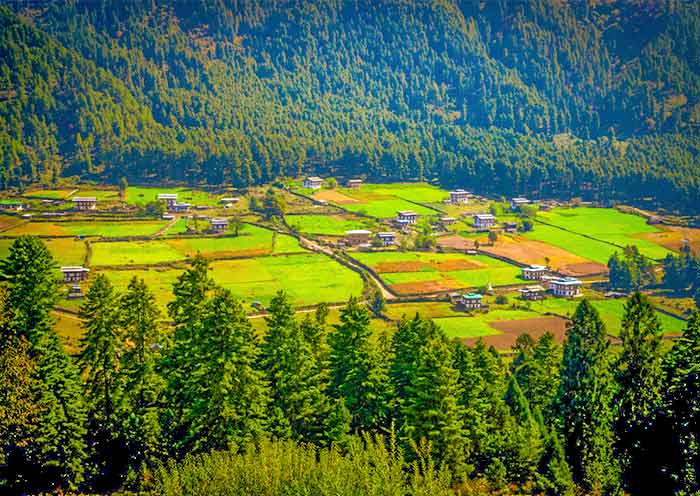
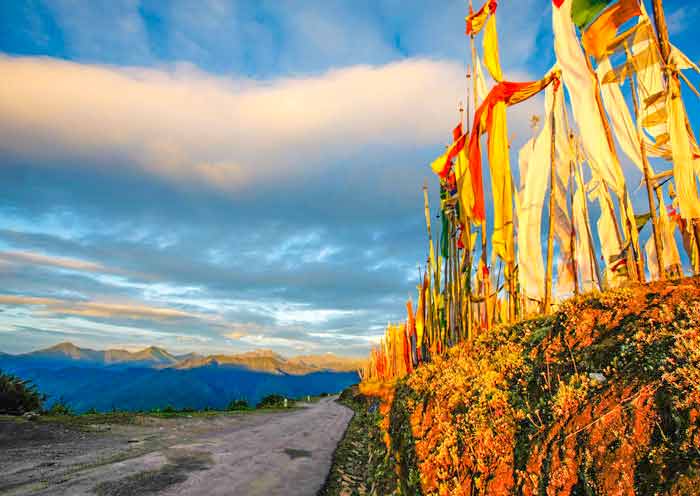

After breakfast, you will travel from Trongsa to Bumthang. Along the way, you will pass Yongtong La Pass, standing at an altitude of 3425 meters, where you can catch sight of Tibetan stupas and prayer flags. This picturesque drive spans 80 kilometers, leading you towards the captivating cultural destination of Bumthang located in Central Bhutan.
On this day, you will focus your exploration on the highlights of Bumthang. This region is renowned for its rich historical legacy, encompassing legendary tales of Guru Padmasanbhava, Pema Linga, and other devoted treasure discoverers known as tetrons. It can rightfully be called the heart of spirituality in the Land of Thunder Dragons. Bumthang is a captivating blend of four magnificent valleys: Chumey, Ura, Choekhor, and Tang. This flat expanse of land is adorned with numerous religious establishments, creating a picturesque tapestry. Besides its pristine natural beauty, you will encounter friendly locals, clustered settlements, and a vibrant atmosphere, all of which have contributed to Bumthang's reputation as a must-visit tourist destination in Bhutan.
After breakfast, your first stop will be Kurjey Lhakhang. This temple complex holds great significance and is known for its expansive size, active religious practices, and cultural importance. It derives its name from the body print (kur) left by Guru Rinpoche. This is the very place where Guru Rinpoche, also known as Padmasambhava, successfully subdued the deity Shelging Karpo. During his profound meditation in this location, Guru Rinpoche left his physical imprint within the caves, giving rise to the name Kurjey, which symbolizes the fusion of "Kur" (body) and "Jey" (imprint). Kurjey Monastery covers a substantial area and encompasses three distinct temples within its premises. Kurjey Lhakhang comprises three buildings: Guru Lhakhang (built in 1652), Sampa Lhundrup Lhakhang (built in 1900), and Ka Gon Phor Sum Lhakhang (built-in 1900). According to ancient tales, the revered Guru Padmasambhava (Rinpoche) meditated in this very place for a period of three months during the 8th century. The upper floor of Kurjey Lhakhang is adorned with 1000 small statues of Guru Rinpoche, adding to the spiritual ambiance. As you approach the entrance of the temple, you will be greeted by a majestic cypress tree, believed to have sprouted from Guru Rinpoche's walking stick. This sacred site is a must-visit destination in Bumthang, offering a profound and awe-inspiring experience.
Next, let's proceed to Jambay Lhakhang, one of Bhutan's most ancient temples. This remarkable temple is believed to have been constructed in 659 by King Songtsen Gampo of Tibet, on the same auspicious day as Kyichu Lhakhang in Paro. Its purpose was to subdue a Tibetan demoness, with the temple said to have pinned her left knee. Guru Rinpoche also visited this temple, and it underwent renovations by Sindhu Raja after the Guru revitalized his life force. Jambay Lhakhang exudes an unmistakable sense of antiquity, making it a truly captivating site in the valley. Inside the main Jampey (Jampa) Lhakhang, you will discover three stone steps that symbolize three different ages. The first step represents the past, the time of the historical Buddha, Sakyamuni. This step has descended into the ground and is covered with a wooden plank. The next step represents the present age and is level with the floor. Finally, the top step represents the future, signifying a new age. It is believed that when the step representing the present age sinks to ground level, the gods will assume human form and the current world will come to an end. Make sure to explore the inner sanctum, where you will find the central figure of Jampa, the Buddha of the future, depicted with his feet resting on an elephant. This section is the oldest part of the oldest chapel in Bhutan and holds great historical significance. As you take the inner kora path around the chapel, you will be surrounded by ancient murals depicting 1000 Buddhas, adding to the spiritual ambiance. Don't forget to also admire the Kalachakra Temple and two large stone chortens during your visit.
Later, you'll visit Jakar Dzong. According to legend, in 1549, a group of lamas gathered to find a suitable location for a monastery. Suddenly, a magnificent white bird took flight and landed on a hill spur. This extraordinary event was interpreted as a universal sign, leading to the selection of that very hill for the construction of the monastery, which came to be known as Jakar Dzong. The sheer magnificence and scale of Jakar Dzong, coupled with the stone pathway meandering through the verdant forest, have enchanted countless travelers. Established in 1549 AD under the guidance of Lam Ngagi Wangchuk, who journeyed to Bhutan to disseminate the teachings of Drukpa Kagyu, Jakar Dzong stands as a resplendent and formidable structure. Ascending to the top of Jakar Dzong, you'll be rewarded with an awe-inspiring view of the enchanting Choekar Valley in Bumthang.
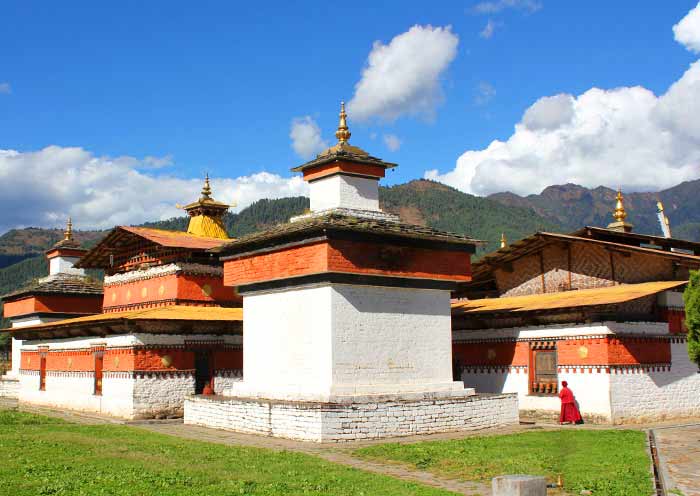
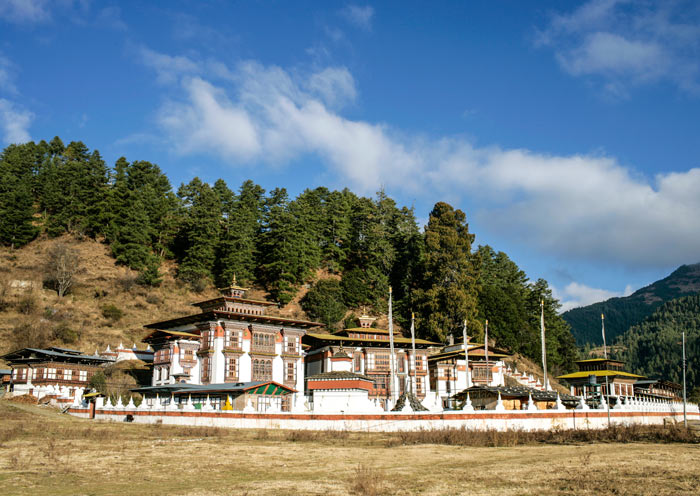
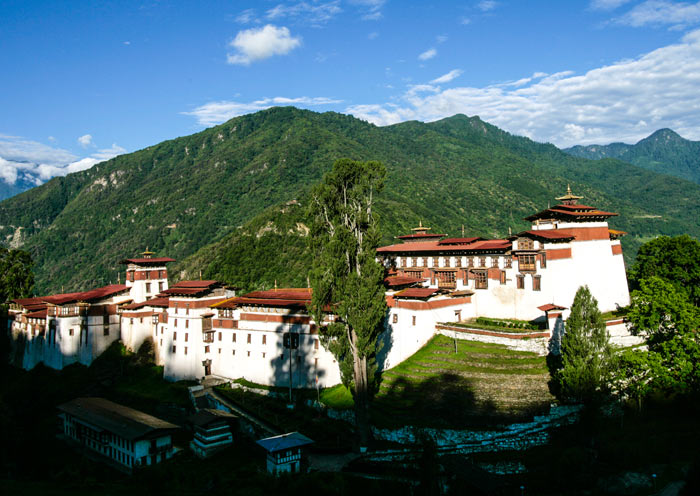
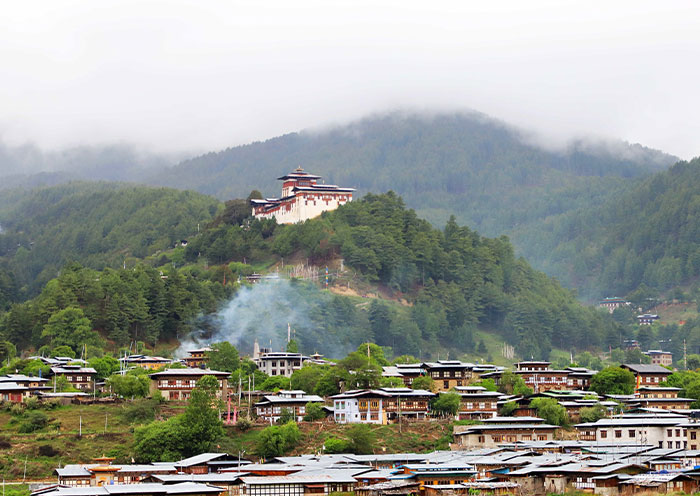
After breakfast, you will depart from central Bhutan and head back to Western Bhutan. Along the way, you will make a stop in Wangdue Phodrang. The distance from Bumthang to Wangdue Phodrang is approximately 200 kilometers, and the car journey takes approximately 6 hours.
Upon your arrival in Wangdue Phodrang, make sure to visit Rinchengang Village, one of the oldest villages in Bhutan. This quaint clustered village is renowned for its mastery of traditional stonework. The village's fame stems from its deep-rooted cultural heritage and the exceptional craftsmanship displayed in its traditional stonework. Situated across the Wangdue Phodrang Dzong, with the Punatsangchhu River flowing alongside the highway, Rinchengang Village is nestled amidst hilly terrain. From a small hillock, you can enjoy a breathtaking view of the majestic Wangdue Phodrang Dzong, while traditional houses grace the landscape, adding to its picturesque charm. Rinchengang Village is also known for its warm and welcoming locals, who eagerly share their cultural traditions with visitors. By immersing yourself in the village, you can gain insight into the authentic Bhutanese way of life. Explore the narrow alleys and cobbled streets that wind through the village, passing by traditional houses adorned with intricate carvings and paintings.
Stay in Wangdue Phodrang.
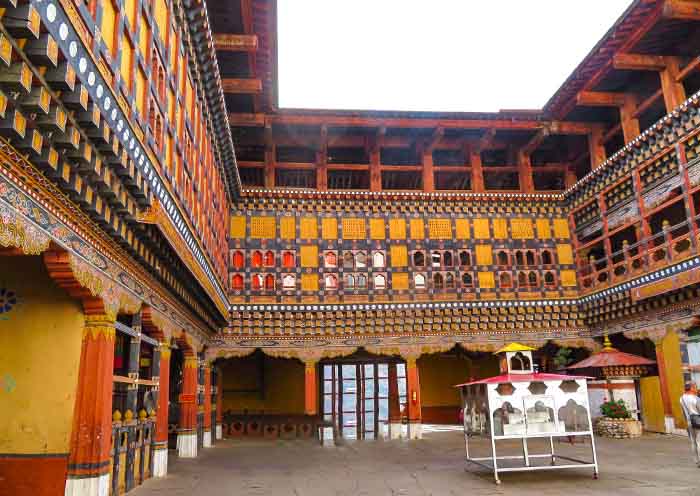
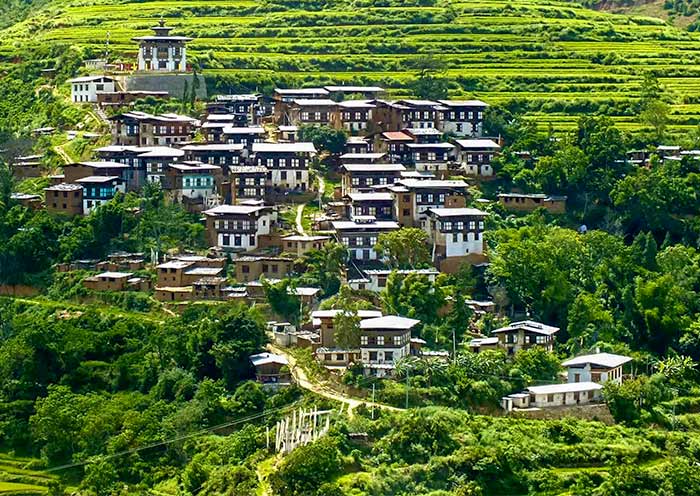
After breakfast, you will begin your return journey from Wangdue Phodrang to Paro (110km, about 3 hours). After arrive in Paro, you will have the opportunity to visit Paro Dzong (Rinpung Dzong). This magnificent fortress stands tall and proud, serving as a beacon of history and culture in Bhutan. Rinpung Dzong was constructed in 1646 by Shabdrung Ngawang Namgyal (1594-1651), a pivotal figure in Bhutanese history who is revered as the founder of the modern Bhutanese state and a national hero. His enduring legacy continues to shape the country's identity and cultural landscape. Located near the pristine Paro Chu River, Paro Dzong can be accessed via a traditional wooden cantilever bridge, providing you breathtaking panoramic views of the enchanting Paro Valley.
If you hike a little further, you will reach the Bhutan National Museum (Ta Dzong), which holds the distinction of being Bhutan's tallest building. Originally constructed in 1649 as a watchtower overlooking the Paro Dzong, it was later transformed into the National Museum of Bhutan in 1968. At the museum, you can immerse yourself in a rich collection of ancient artifacts such as pottery, armor, thangkas, masks, stamps, photographs, statues, costumes, relics, stone axes, and religious paintings.
Note: Please note that Paro Dzong is open from 9 AM to 5 PM on weekdays and from 10 AM to 4 PM on weekends. If you can't make it to the opening hours, we suggest visiting the Paro Local Market instead. It's a place where locals and tourists alike come to shop for traditional Bhutanese handicrafts, textiles, jewelry, and other local produce. It offers a glimpse into the daily life and culture of Bhutan.
Stay overnight in Paro.
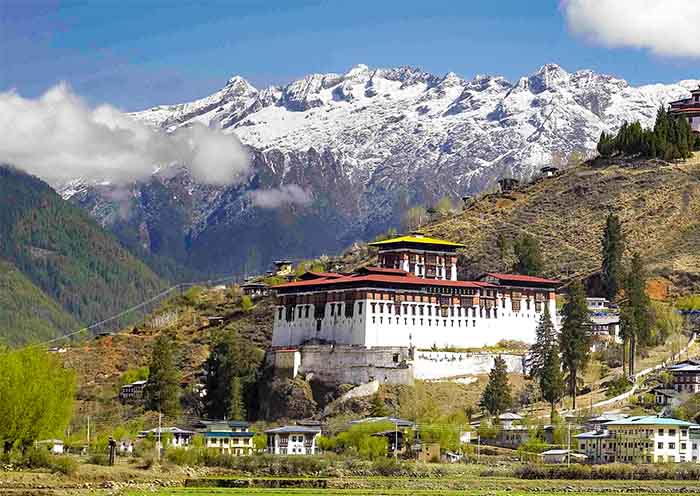
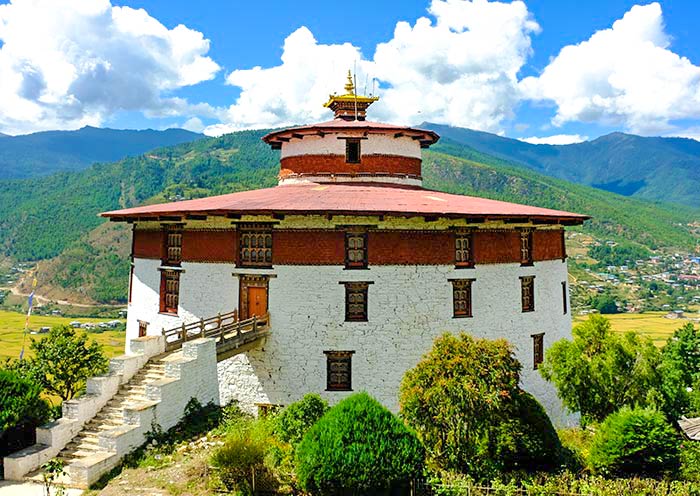
This morning, you will enjoy the exciting hiking tour to Tiger's Nest, the landmark of Bhutan and the most famous holy monastery in the country. It is about a 12km drive (over 0.5 hour) from Paro city to the start point of the Tiger's Nest hike route.
Usually, it may takes about 2.5 hours to reach Tiger's Nest Monastery (Paro Taktsang) on foot. The entire Tiger's Nest Hike takes around 5 to 6 hours, with about 2.6km of uphill trekking and about 2.6km of downhill walking. You have the option to rent a horse at the designated place if you prefer. Riding a horse (self-payment required), it takes about 1.5 hours to reach the halfway point on the mountainside. From there, you need to say goodbye to your horse and hike for another 1.5 hours to reach the Tiger's Nest Monastery. At the halfway point, there is a Taktsang Cafeteria where you can have a buffet lunch and enjoy coffee and tea. What is more it is the first viewpoint where you can look up at Tiger's Nest Monastery, the incredible religious site of Buddhists. As the viewing position ascends, the outline of Tigers Nest Monastery becomes increasingly clear. On the journey ahead, you can enjoy the hike in Bhutan’s forest and will see more and more prayer flags and prayer wheels, left behind by the Bhutanese people who come here to worship. You will also have a panoramic view of the beautiful Paro Valley below. If you visit in April, you will have the opportunity to see the high-altitude rhododendrons blooming, creating a stunning display of red clouds amidst the mountains.
Then, you will stand right opposite the Taktsang Goemba (Tiger's Nest Monastery) and admire Bhutan's most iconic cultural landmark, which is renown as one of the world's top ten super monasteries. The Tiger's Nest (3,120m) is sited on the side of a cliff at a height of 900m above the Paro Valley (2,270m). According to legend, the Indian sage Guru Padmasambhava (Guru Rimpoche, the founder of the Nyingma school of Tibetan Buddhism and the builder of the first monastery in Tibet - Samye Monastery) arrived at the location of Tiger's Nest Monastery in the 8th century. It is said that he rode a tigress and subdued demons before spending 3 months meditating in the mountain caves here. This eventually led to the formation of the present-day Tiger's Nest Monastery. Throughout history, this place has been considered a sacred site by Buddhist luminaries. However, it wasn't until 1692 that the current structure of Tiger's Nest Monastery took shape. In 1998, a devastating fire caused significant damage, but it was reconstructed in 2005, closely resembling the original architectural design. If you are interested you can hike into the monastery to explore more (no photo inside). Today, Tiger's Nest Monastery, one of the most visited tourist attractions in Bhutan, is revered as the holiest pilgrimage site for Bhutanese people to visit at least once in a lifetime.
Then, it is time to visit Kyichu Lhakhang, also known as the Temple of the Thousand-armed and Thousand-eyed Avalokiteshvara. It is one of the 108 Buddhist temples built by King Songtsen Gampo in the 7th century (around 659 AD), and it is believed to have been constructed to subdue the left leg of the Tibetan witch. Kyichu Lhakhang is also one of the oldest Tibetan Buddhist temples in Bhutan and serves as a venue for important celebrations of the Bhutanese royal family. In the main hall of Kyichu Lhakhang, you can see the revered statue of an eight-year-old Shakyamuni Buddha, believed to have been created during the same period as the Jowo statue in the Jokhang Temple in Lhasa, Tibet. It is considered a national treasure of the Kingdom of Bhutan. Apart from housing many precious historical artifacts and Buddhist scriptures, the temple also enshrines the relic stupa of Dilgo Khyentse Rinpoche (1910-1991), a renowned master of the Nyingma tradition. Additionally, there is a piece of iron chain forged by Tangtong Gyalpo, who was the former head of the four major Tibetan Buddhist schools and is known as the Iron Bridge Living Buddha and the father of Tibetan opera.
Optional Bhutan Paro Experiences:
Bhutan Traditional Hot Stone Bath (1 hour).
Lighting butter lamps for blessings at Kyichu Lhakhang (108 lamps).
Dinner with Bhutanese Culture Dance Show.
Kind Reminds:
1. The best time to visit Tiger's Nest is from March to May and from October to December. After noon, the monastery will be hidden in the shadow of the cliffs, so it's recommended to depart early if you want to capture good photos.
2. Tiger's Nest offers horse riding services to go uphill, but the horse ride is only available up to a designated point. From there, you still need to hike to reach the monastery. When descending, you must walk the entire way as horse riding services are not provided.
3. Mobile phones and backpacks are not allowed inside Tiger's Nest Monastery. Personal belongings can be stored at the entrance. If you wish to light butter lamps, make sure to have some cash ready before storing your belongings.
4. Along the way, you may encounter stray dogs. Please be mindful, give them space, and avoid disturbing them.
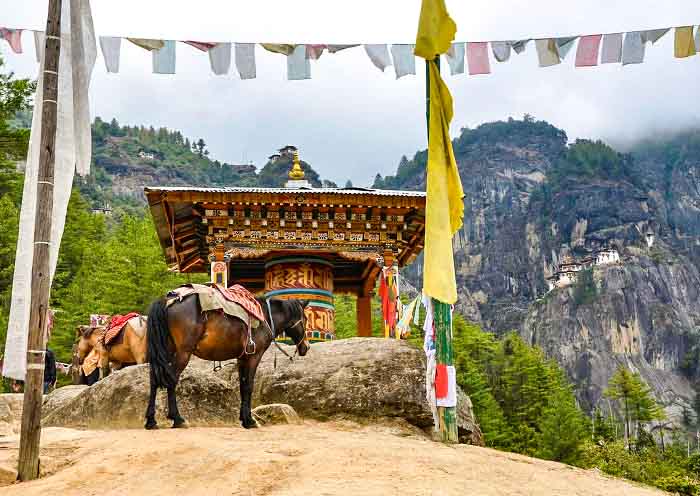
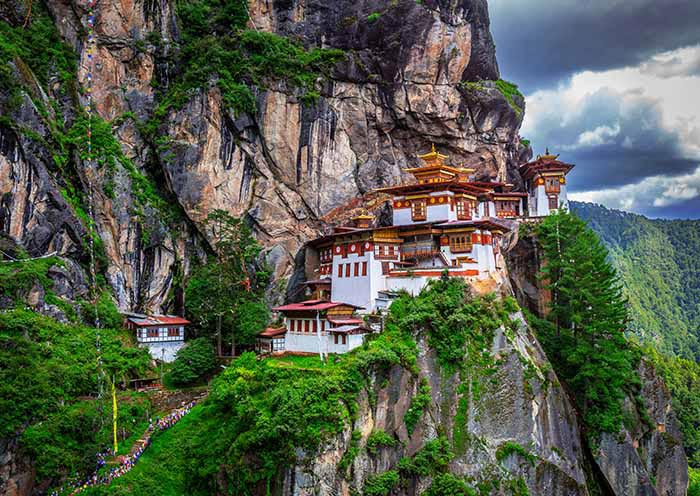

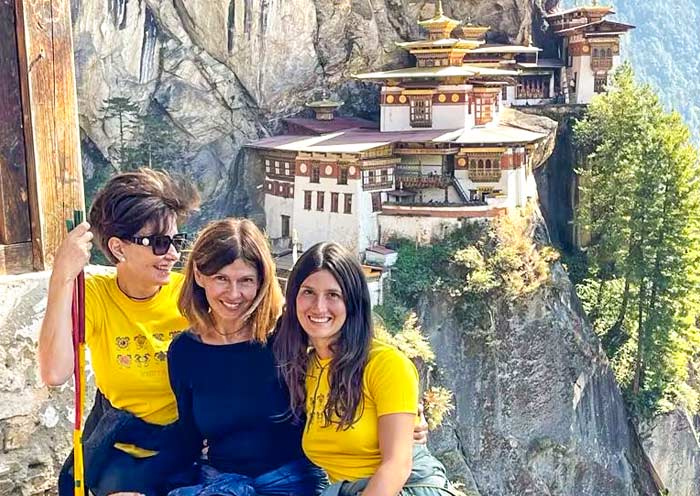
Time to say goodbye to Bhutan, the beautiful Himalayan country. It is time to end your 12-day Nepal Bhutan Tour. Your guide will say goodbye to you and you will continue on your next destination.
Thank you for choosing Asia Odyssey Travel (AOT) for your Asia Tour, and we are always here working for you and hope to see you again for your next trip to China/Asia. Safe journey!
Note: Please be advised that certain sites on the itinerary may be subject to change due to seasonal changes, weather conditions, national holidays, and special events. We reserve the right to modify the itinerary in order to enhance your tour experience in Nepal and Bhutan. Any changes made to the itinerary will be done with your best interests in mind.
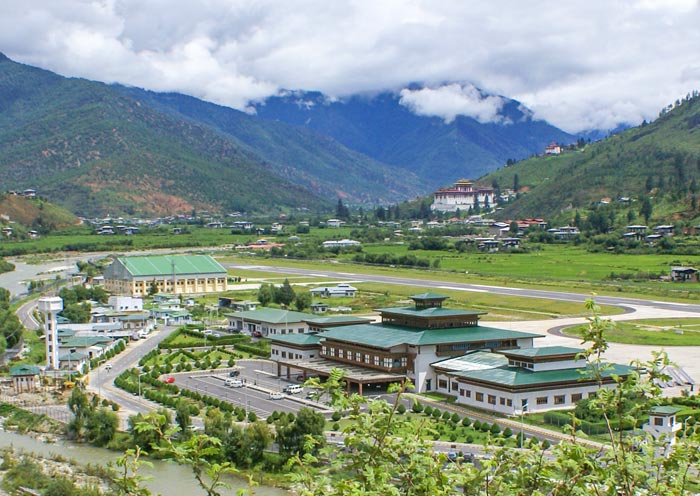
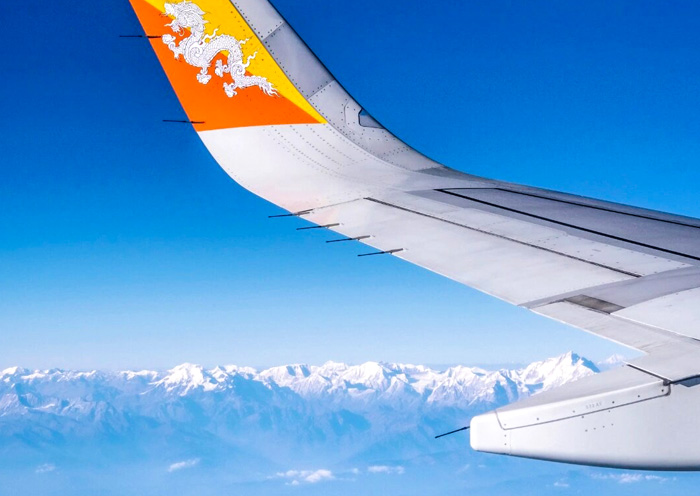
Price: What’s Included & What’s Excluded
What’s Included:
What’s Excluded:
Important Travel Tips for Visiting Nepal
Before your trip, it is important to check the visa requirements for Nepal and ensure that you have all the necessary documents. The most common method of obtaining a tourist visa for Nepal is through Visa on Arrival. This means you can get your visa upon arrival at the Tribhuvan International Airport in Kathmandu or at designated land border crossings if you are entering Nepal overland.
To facilitate the visa application process, it is recommended to provide your detailed information to your travel experts before making any reservations. They can then offer you personalized suggestions and guidance regarding the visa application process. This will help ensure that you have all the necessary information and documentation to successfully apply for your Nepal visa.
Nepal's climate is diverse due to its varied topography, spanning from lowland plains to the towering Himalayas. The optimal times to visit Nepal are generally in autumn (October and November) and spring (March to May). During these seasons, the weather is mild and pleasant, making it an ideal time for outdoor activities, trekking, and mountain climbing. Additionally, important cultural festivals like Holi, Nepal Losar, Indra Jatra, and Dasain take place during these periods, adding to the vibrant atmosphere.
On the other hand, the summer season (June to September) in Nepal coincides with the monsoon season, characterized by heavy rainfall. While the monsoon brings lush greenery to the landscape, it can also lead to challenging conditions for outdoor activities.
Highways connecting major cities and towns in Nepal are generally well-maintained and in good condition. Some sections of these highways may experience occasional maintenance or repair work, which can cause temporary disruptions or delays.
If you are traveling from the Gyirong Border to Kathmandu, which is approximately 130-150 kilometers away, the journey can take around 6-7 hours by road. Similarly, if you plan to visit destinations like Pokhara, Chitwan, or Lumbini from Kathmandu, it generally takes about 5-7 hours of driving.
Alternatively, if you prefer a quicker and more convenient option, there are direct flights available from Kathmandu to Pokhara, Chitwan, and Lumbini. Considering a flight transfer can save you time and offer a more comfortable travel experience.
The official currency of Nepal is the Nepalese Rupee (NPR). It is recommended to carry a combination of cash (in small denominations) and a debit or credit card. ATMs are widely available in major cities, but may be limited in remote areas.
(1) When in Nepal, it is customary to greet others with "Namaste," a traditional greeting that involves joining your palms together in a prayer-like gesture and saying "Namaste" while slightly bowing. This gesture shows respect and is widely appreciated.
(2) Nepal is home to a significant population practicing Hinduism and Buddhism. It is important to demonstrate respect when visiting religious sites. Remember to dress modestly, remove your shoes, and adhere to any specific rules or rituals observed at each location, such as covering your shoulders or refraining from certain actions.
(3) If you wish to take photographs of religious ceremonies or individuals, it is polite to seek permission first. Some religious sites may have restrictions on photography, and it's important to respect the privacy and sacredness of the moment.
(4) Nepal celebrates numerous festivals throughout the year, providing a fantastic opportunity to immerse yourself in the vibrant culture and traditions. During these festive occasions such as Dashain, Tihar, Holi, and Buddha Jayanti, it is customary to exchange greetings, offer and receive blessings, and participate in religious rituals. Embrace the festive spirit and engage respectfully in the celebrations.
(5) By being mindful of these customs and traditions, you can show your appreciation for the Nepalese culture and ensure a more enjoyable and respectful experience during your visit.
Hotel Conditions for Your Nepal Tour
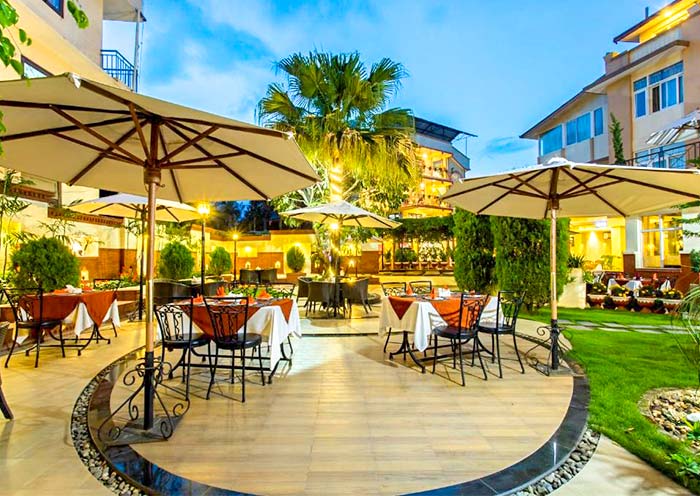

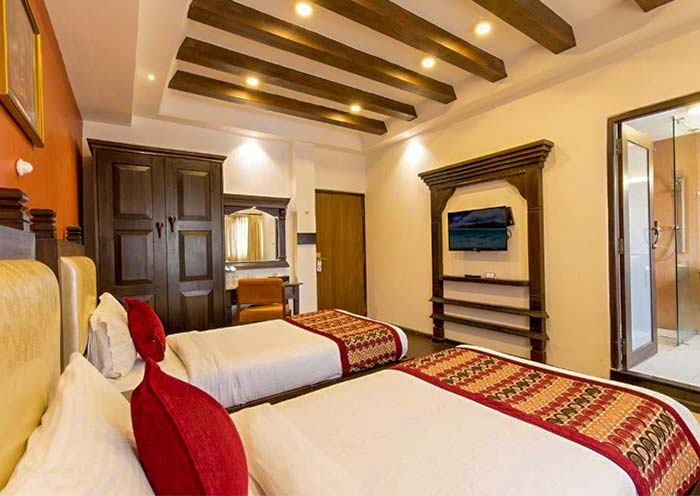
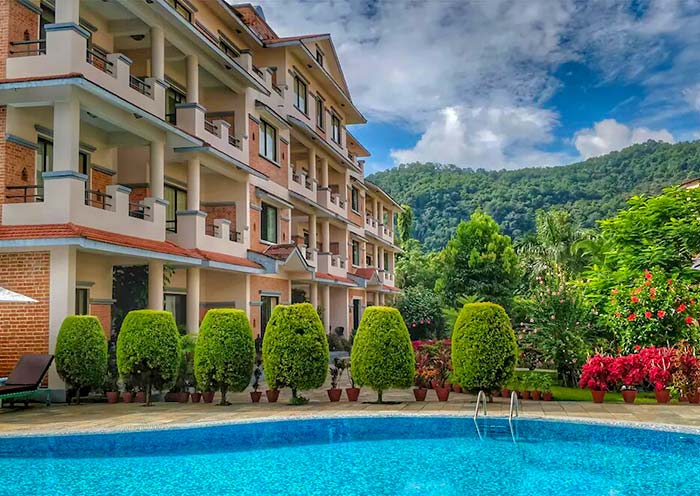
In Nepal, most travelers typically allocate 3-4 nights in Kathmandu, 2 nights in Pokhara, 2 nights in Chitwan, 1 night in Nagarkot, or 2 nights in Lumbini. To cater to various travelers' preferences and budgets, we offer a range of carefully chosen accommodations, including luxurious 5-star hotels, comfortable 4-star options, and economical 3-star establishments.
1. Find your perfect hotel for a great experience: We offer a diverse selection of hotels in Nepal, catering to all types of travelers. Our knowledgeable travel experts can provide you with various pricing options based on different hotels. Whether you seek a luxurious stay or have specific preferences, our experts will assist you in choosing the best option that suits your needs.
2. Single Room Option: By default, our tour package assumes that two people will share a room. However, if you prefer a private room, there will be an additional charge for a single room supplement. This supplement ensures that you have a room to yourself, ensuring enhanced comfort and privacy throughout your stay.
Photo Gallery for This Itinerary
Latest Nepal Bhutan Tours Reviews from Our Customers

cindy heng
Malaysia
Date of Experience: Sep 07, 2025
Tour Customized by: Abby
You May be Interested in This Tour: Customized Tour

mui m
Vietnam
Highly recommend Asia Odyssey - they planned a fantastic itinerary against our brief for Tibet, Nepal, and Bhutan. Special shoutout to Ms. Mandy who planned our trip, answered all our questions, was incredibly responsive, and was always helpful. She checked in during our trip to make sure we were okay as well. On our trip, our local guides were knowledgeable and kind and our accommodation was comfortable. All-in-all a fantastic experience and highly recommended.
Thank you for a wonderful experience!!
Destination(s): Tibet
Date of Experience: Jun 05, 2025
Tour Customized by: Mandy
You May be Interested in This Tour: Customized Tour

Bhawani Thangaratnam
Malaysia
Date of Experience: Aug 31, 2025
Tour Customized by: Steven
You May be Interested in This Tour: Customized Tour
Price: Request
(Based on a private tour for two people. Price varies depending on program, travel date, number of people.)
Free Enquiry! You don’t need to pay for the reservation.
- United States (+1)
- Australia (+61)
- Singapore (+65)
- Malaysia (+60)
- Philippines (+63)
- Canada (+1)
- Italy (+39)
- Indonesia (+62)
- United Kingdom (+44)
- Spain (+34)
- Mexico (+52)
- Hong Kong (+852)
- Thailand (+66)
- United Arab Emirates (+971)
- New Zealand (+64)
- South Africa (+27)
- Germany (+49)
- Brazil (+55)
- India (+91)
- France (+33)
- Vietnam (+84)
- The Netherlands (+31)
- Saudi Arabia (+966)
- Ireland (+353)
- Argentina (+54)
- Switzerland (+41)
- Romania (+40)
- Pakistan (+92)
- Japan (+81)
- Portugal (+351)
- Bangladesh (+880)
- South Korea (+82)
- Puerto Rico (+1)
- Türkiye (+90)
- China (+86)
- Belgium (+32)
- Qatar (+974)
- Greece (+30)
- Taiwan (+886)
- Austria (+43)
- Poland (+48)
- Israel (+972)
- Chile (+56)
- Sri Lanka (+94)
- Nigeria (+234)
- Peru (+51)
- Colombia (+57)
- Hungary (+36)
- Nepal (+977)
- Denmark (+45)
- Bulgaria (+359)
- Norway (+47)
- Slovenia (+383)
- Sweden (+46)
- Kuwait (+965)
- Costa Rica (+506)
- Ecuador (+593)
- Venezuela (+58)
- Malta (+356)
- Croatia (+385)
- Tunisia (+216)
- Czechia (+420)
- Mongolia (+976)
- Bahrain (+973)
- Mauritius (+230)
- Papua New Guinea (+675)
- Cambodia (+855)
- Dominican Republic (+1)
- Luxembourg (+352)
- Finland (+358)
- Guatemala (+502)
- Myanmar (+95)
- Maldives (+960)
- Slovakia (+421)
- Laos (+856)
- Serbia (+381)
- Brunei (+673)
- Oman (+968)
- Macao (+853)
- Panama (+507)
- Morocco (+212)
- Jordan (+962)
- Georgia (+995)
- Fiji (+679)
- Bolivia (+591)
- Lithuania (+370)
- Bahamas (+1)
- Cyprus (+357)
- Latvia (+371)
- Bhutan (+975)
- Iraq (+964)
- Iran (+98)
- Kenya (+254)
- Jamaica (+1)
- Zimbabwe (+263)
- Azerbaijan (+994)
- Uruguay (+598)
- Estonia (+372)
- Andorra (+376)
- Cameroon (+237)
- Ghana (+233)
- Kazakhstan (+7)
- Nicaragua (+505)
- Egypt (+20)
- Russia (+7)
- Albania (+355)
- Réunion (+262)
- Montenegro (+382)
- Algeria (+213)
- Afghanistan (+93)
- Martinique (+596)
- Uganda (+256)
- Honduras (+504)
- North Macedonia (+389)
- Trinidad and Tobago (+1)
- Suriname (+597)
- Antigua and Barbuda (+1)
- Zambia (+260)
- Ukraine (+380)
- Armenia (+374)
- Barbados (+1)
- Belarus (+375)
- Palestine (+970)
- Lesotho (+266)
- Moldova (+373)
- Ethiopia (+251)
- French Polynesia (+689)
- Gambia (+220)
- Guam (+1)
- Gibraltar (+350)
- Isle of Man (+44)
- New Caledonia (+687)
- El Salvador (+503)
- Comoros (+269)
- Seychelles (+248)
- Chad (+235)
- Samoa (+685)
- Cook Islands (+682)
- Palau (+680)
- Paraguay (+595)
- DR Congo (+243)
- Solomon Islands (+677)

